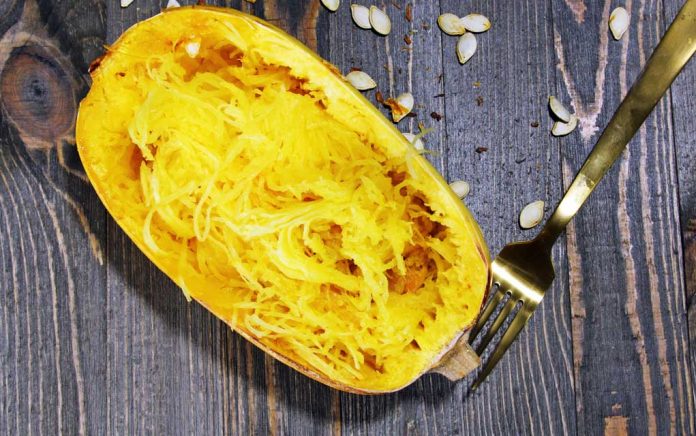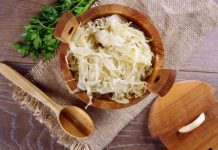
When it comes to eating well, variety is the spice of life. It’s also great for your good gut bacteria who thrive on extracting nutrients from as many kinds of veggies as they can get. However, with our too-busy-to-cook-from-scratch lifestyles, it’s easy to get stuck in a rut, eating the same foods over and over again. So how about changing things up? How about surprising your taste buds and good gut bacteria with a heaping helping of nutrient-dense spaghetti squash? There’s so much to love about them, it’s time to give ‘em a second look. Here’s a topline on my favorite golden gourd, and a bunch of very good reasons to dig in.
1. Spaghetti Squash Gives You a Big Bang for Your Nutritional Buck
To keep your gut functioning optimally and immunity high, you’ve got to “eat the rainbow.” That means plenty of veggies in a variety of colors – green, purple, red, yellow, orange—in order to access the widest range of nutrients. When you add spaghetti squash’s sunny yellow insides to your plate, you’ll be filling up with many of the vitamins, minerals and nutrients that are essential to sustainable wellness, including vitamin A, B and C, potassium, folic acid, beta-carotene and omega-3 essential fatty acids.
2. It’s Easy to Pick a Winner
The good news is that It’s relatively easy to pick a good spaghetti squash. At the market, be on the lookout for ones that feel solid and heavy, with skin that’s bright yellow. The skin should be firm and the stem should be dry, not wet or moldy. If the skin’s got a few minor scratches, that’s ok, but if there are actual cracks or mushy spots, keep looking.
3. Spaghetti Squash is an Easy-care Veggie
When it comes to storage, spaghetti squash need no special treatment. You don’t have to be in a rush to cook them either. Sitting pretty in a bowl on the counter at room temperature, the humble spaghetti squash will be just fine for up to a month. In the fridge they can last even longer, but why delay joy? When you’re ready to cook, give your squash a quick bath in the sink and let the games begin.
4. Spaghetti Squash Is Incredibly Easy to Cook
Probably the toughest thing about spaghetti squash is cutting it open! To do it safely, first take a look at Paleo author Melissa Joulwan’s helpful how-to tutorial. Once the splitting’s done, the cooking part is simple: Scoop out the seeds. Add a splash of water to the bottom of the dish. Place both halves face down in the baking dish. Bake for about 30 – 45 minutes at 375 degrees. Remove from oven, let cool before scooping out the strands and strain off any extra liquid. If you’re a spaghetti squash newbie, then take a look at thekitchn.com’s beautifully illustrated, simple step-by-step cooking instructions.
5. Spaghetti Squash Plays Well With Others
After cooking, scoop out the spaghetti-like strands. Serve au naturale, or dress up with herbs and spices, or toss with a little pesto or sauté with garlic, olive oil and capers. Feeling creative and craving leafy greens? Try this delicious recipe for sautéed spaghetti squash with collard greens. For a no-cook way to get your fill, toss some cooked spaghetti squash into your lunchtime salad. To turn a basic soup in to a hearty meal, add a serving of spaghetti squash, plus sautéed spinach, caramelized onions and a few ounces of shredded organic chicken to the mix. More veggies, more fiber, more nutrition, all in one bowl – what could be better.
6. They’ll Save You Money and Time
Spaghetti squash offers a nice return on your investment – a great nutritional yield for a very reasonable outlay. Prices vary, but you can pick up a nice 4 or 5-pounder for roughly $1 – $2 per pound. That will get you about four servings or roughly 4-to-6 cups of cooked squash. Serve half and freeze the restfor another meal or two or to bulk up soups and salads, as suggested above. Another bonus: Like their pumpkin cousins, spaghetti squash seeds can be planted, so if you have a patch in the back yard and a bit of a green thumb, you can try your hand at growing a few golden gourds of your own.
And for a delicious dinner idea, try Be Well Health Coach Amanda Carney’s swift and simple Spaghetti Squash with Cherry Tomatoes and Kale recipe. Bon appétit!
[This article originally appeared on DrFrankLipman.com.]










